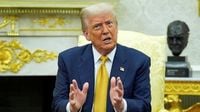In a significant yet contentious development in international trade and geopolitics, the United States has imposed a 19-percent tariff on goods exported from the Philippines, following a high-profile meeting between US President Donald Trump and Philippine President Ferdinand Marcos Jr. at the White House on July 22, 2025. This tariff, slightly lower than the initially threatened 20 percent but higher than the 17 percent announced earlier in April, marks a complex chapter in the trade relations between the two countries amid rising tensions in the Indo-Pacific region.
President Trump confirmed the trade deal on social media platform Truth Social shortly after hosting Marcos, stating, “It was a beautiful visit, and we concluded our Trade Deal, whereby The Philippines is going OPEN MARKET with the United States, and ZERO Tariffs. The Philippines will pay a 19% Tariff.” Despite the announcement, the exact terms of the agreement remain undisclosed, and no formal documents were immediately available to the public. Trump had earlier expressed reservations about the negotiations, telling reporters, “I’m not ready to make a deal with him. He’s negotiating too tough,” but conceded, “We’ll probably agree to something.”
From the Philippine perspective, Malacañang downplayed the impact of the tariff, emphasizing that the country's economy would feel minimal effects. Palace press officer Undersecretary Claire Castro highlighted that only 16 percent of Philippine exports go to the US, and notably, 67 percent of these exports are from the semiconductor and electronics industries, which are protected by zero-tariff provisions under global trade agreements. “Based on records, the Philippines is not dependent on US exports. In other words, there is an effect, but its impact on the country is not that significant,” Castro explained during a virtual briefing.
President Marcos Jr. described the reduction from the initially proposed 20 percent tariff to 19 percent as a “significant achievement,” following his meeting with Trump. Compared to other Southeast Asian nations, the Philippines now faces the second-lowest reciprocal tariff imposed by the US, with Singapore bearing a 10 percent rate. Meanwhile, the Philippines has offered the US open market access and zero tariffs on certain goods, including opening its automobile market to American imports, effectively eliminating tariffs in that sector.
The backdrop to this trade agreement is a broader context of fluctuating tariffs and economic uncertainty. Earlier in April 2025, the Trump administration announced a sweeping slate of tariffs on nearly every country, including a 17 percent tariff on Philippine exports, which was temporarily paused. The sudden increase to 20 percent in early July, without explanation, prompted Marcos to travel to Washington at Trump’s invitation to negotiate a resolution.
However, the concessions recommended by the Philippine Department of Trade and Industry (DTI) ahead of the meeting have drawn criticism for their “colonial character,” as they grant US business interests extensive access to Philippine resources and economy. These proposals include preferential access to mineral reserves like nickel, cobalt, and copper, elimination of nearly all Philippine tariffs on US goods, import commitments favoring US exports, and special access for American firms in vital sectors such as energy and infrastructure.
Beyond trade, the visit included discussions on security concerns and preparations for potential conflict with China. Secretary of Defense Pete Hegseth, part of the US delegation, underscored the Mutual Defense Treaty (MDT) between the US and the Philippines, signed in 1951, suggesting it covers mutual defense against any actions on either country’s forces, including the Coast Guard, “anywhere in the Pacific, including the South China Sea.” This expansive interpretation of the treaty, which does not explicitly mention the South China Sea or the Coast Guard, aims to bring ongoing confrontations in these disputed waters within the scope of mutual defense obligations.
In recent years, the US has significantly increased its military presence in the Philippines, establishing nearly ten military bases and deploying advanced weaponry such as the Typhon missile system, capable of striking much of mainland China. US troops also coordinate Philippine confrontations with Chinese vessels using aerial and marine drones. The Philippines has publicly acknowledged preparations for war in the event of a Chinese invasion of Taiwan, signaling a deepening military alignment with Washington.
These developments have intensified geopolitical tensions and internal political strife within the Philippines. A political civil war is underway between factions aligned with former President Rodrigo Duterte, who sought closer ties with China, and those supporting Marcos, who has realigned the country firmly with the United States. Duterte currently faces trial at The Hague for crimes against humanity, while his daughter, Vice President Sara Duterte, is undergoing an impeachment trial. This internal discord reflects the broader regional struggle over influence between the US and China.
President Trump’s longstanding ties to the Marcos family add another layer of complexity. Trump was known to have close relations with Ferdinand and Imelda Marcos during their dictatorship, a regime responsible for thousands of deaths, mass imprisonments, and widespread corruption. Despite this dark legacy, the Marcos family remains influential, and Trump praised them during the meeting, calling them “a great family, great family legacy, and highly respected in this country.”
Critics argue that the US, under the guise of defending national sovereignty, is actually undermining Philippine sovereignty by maintaining extensive military bases, deploying long-range missiles, and coercing economic concessions that favor American interests. This has led to concerns that the Philippines is becoming a pawn in US efforts to contain China’s rise, with economic measures like tariffs serving as tools of imperialism to assert dominance and realign regional geopolitics.
Financial markets reacted modestly to the tariff announcement, with the Dow Jones Industrial Average rising 115 points (0.26%), the S&P 500 holding steady, and the Nasdaq slipping by 0.37%, indicating cautious investor sentiment amid the trade developments.
As the Philippines navigates these challenges, the government has pledged to enhance the competitiveness of its exports globally, aiming to mitigate the impact of tariffs and economic pressures. The trade deal, military cooperation, and political dynamics underscore the complex interplay of economics and security in the evolving US-Philippines relationship.
The 19-percent tariff deal represents more than just a trade adjustment; it reflects the shifting tides of global power, regional alliances, and the enduring legacies of history that continue to shape the Philippines’ path forward.


